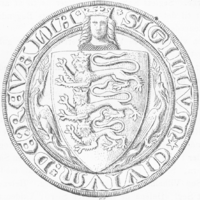
Coat of arms of Tallinn
Encyclopedia

Coat of arms
A coat of arms is a unique heraldic design on a shield or escutcheon or on a surcoat or tabard used to cover and protect armour and to identify the wearer. Thus the term is often stated as "coat-armour", because it was anciently displayed on the front of a coat of cloth...
of the Estonian capital Tallinn
Tallinn
Tallinn is the capital and largest city of Estonia. It occupies an area of with a population of 414,940. It is situated on the northern coast of the country, on the banks of the Gulf of Finland, south of Helsinki, east of Stockholm and west of Saint Petersburg. Tallinn's Old Town is in the list...
. Tallinn is located in Harju County
Harju County
Harju County , or Harjumaa , nowadays one of 15 counties of Estonia. It is situated in northern Estonia, on the south coast of the Gulf of Finland, and borders Lääne-Viru County to the east, Järva County to the south-east, Rapla County to the south, and Lääne County to the south-west.528,468 people...
, Estonia
Estonia
Estonia , officially the Republic of Estonia , is a state in the Baltic region of Northern Europe. It is bordered to the north by the Gulf of Finland, to the west by the Baltic Sea, to the south by Latvia , and to the east by Lake Peipsi and the Russian Federation . Across the Baltic Sea lies...
.
Greater coat of arms
The full coat of arms of Tallinn shows three blue marching, forward-facing (passant gardant) lionLion (heraldry)
The lion is a common charge in heraldry. It traditionally symbolises bravery, valour, strength, and royalty, since traditionally, it is regarded as the king of beasts.-Attitudes:...
s crowned with golden crowns on a golden shield. The shield is topped with a silver helmet placed affronté, with closed visor and red lining. The mantling
Mantling
In heraldry, mantling or lambrequin is drapery tied to the helmet above the shield. It forms a backdrop for the shield. In paper heraldry it is a depiction of the protective cloth covering worn by knights from their helmets to stave off the elements, and, secondarily, to decrease the effects of...
is blue and golden. A golden neck chain featuring a stone hangs around the helmet's neck. The helmet's crest
Crest (heraldry)
A crest is a component of an heraldic display, so called because it stands on top of a helmet, as the crest of a jay stands on the bird's head....
features a golden crown from which a woman protrudes, clad in a red robe and wearing a golden crown, arms crossed before her chest.
History
The three-lion symbol is one of the oldest Estonian symbols. It has been used since the 13th century and derives from the armsCoat of arms of Denmark
The royal coat of arms is more complex. The shield is quartered by a silver cross fimbriated in red, derived from the Danish flag, the Dannebrog. The first and fourth quarters represent Denmark by three crowned lions passant accompanied by nine hearts; the second quarter contains two lions passant...
of Danish
Denmark
Denmark is a Scandinavian country in Northern Europe. The countries of Denmark and Greenland, as well as the Faroe Islands, constitute the Kingdom of Denmark . It is the southernmost of the Nordic countries, southwest of Sweden and south of Norway, and bordered to the south by Germany. Denmark...
king Valdemar II
Valdemar II of Denmark
Valdemar II , called Valdemar the Victorious or Valdemar the Conqueror , was the King of Denmark from 1202 until his death in 1241. The nickname Sejr is a later invention and was not used during the King's own lifetime...
, contemporary ruler of Northern Estonia
Danish Estonia
Danish Estonia refers to the territories of present-day Estonia that were ruled by Denmark firstly during the 13th–14th centuries and again in the 16th–17th centuries....
.
.svg.png)
Lesser coat of arms
The lesser coat of arms of Tallinn features a silver cross on a red background.History
The lesser coat of arms of Tallinn is also the coat of arms of Harju CountyHarjumaa
Harjumaa, , was an ancient Estonian county. It corresponded roughly to the present territory of Rapla County.- See also :*Danish Estonia*Harju County*Rapla County*History of Estonia*Livonian Crusade*Rulers of Estonia...
and depicts the Dannebrog
Flag of Denmark
The national flag of Denmark, Dannebrog is red with a white Scandinavian cross that extends to the edges of the flag; the vertical part of the cross is shifted to the hoist side...
cross.
See also

- Harju CountyHarju CountyHarju County , or Harjumaa , nowadays one of 15 counties of Estonia. It is situated in northern Estonia, on the south coast of the Gulf of Finland, and borders Lääne-Viru County to the east, Järva County to the south-east, Rapla County to the south, and Lääne County to the south-west.528,468 people...
- TallinnTallinnTallinn is the capital and largest city of Estonia. It occupies an area of with a population of 414,940. It is situated on the northern coast of the country, on the banks of the Gulf of Finland, south of Helsinki, east of Stockholm and west of Saint Petersburg. Tallinn's Old Town is in the list...
- Danish EstoniaDanish EstoniaDanish Estonia refers to the territories of present-day Estonia that were ruled by Denmark firstly during the 13th–14th centuries and again in the 16th–17th centuries....

